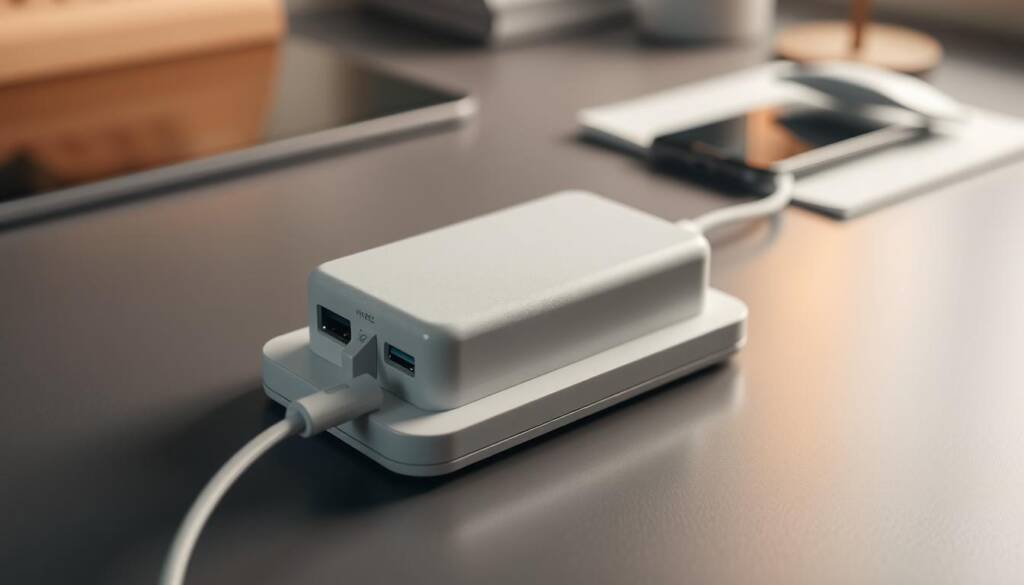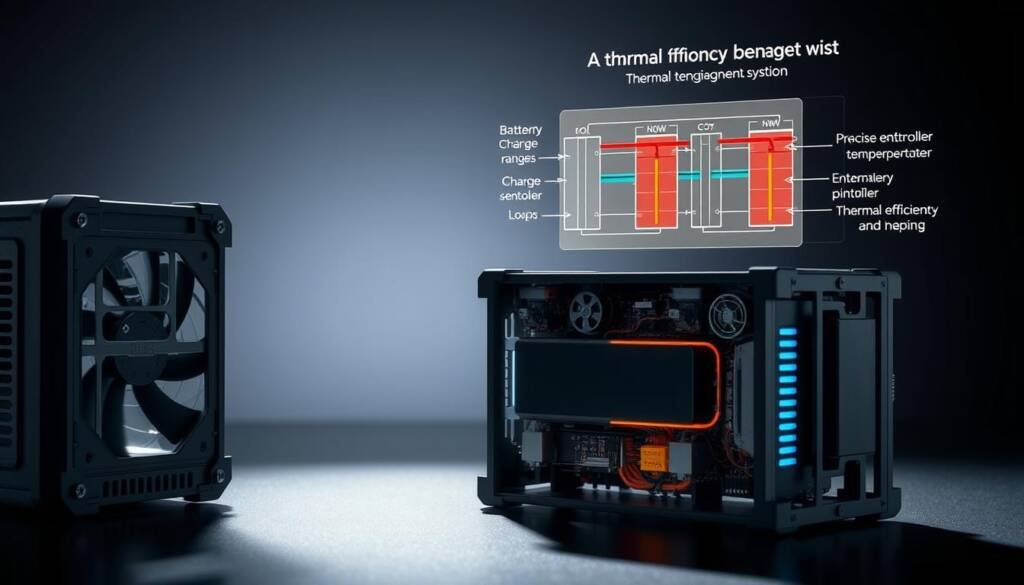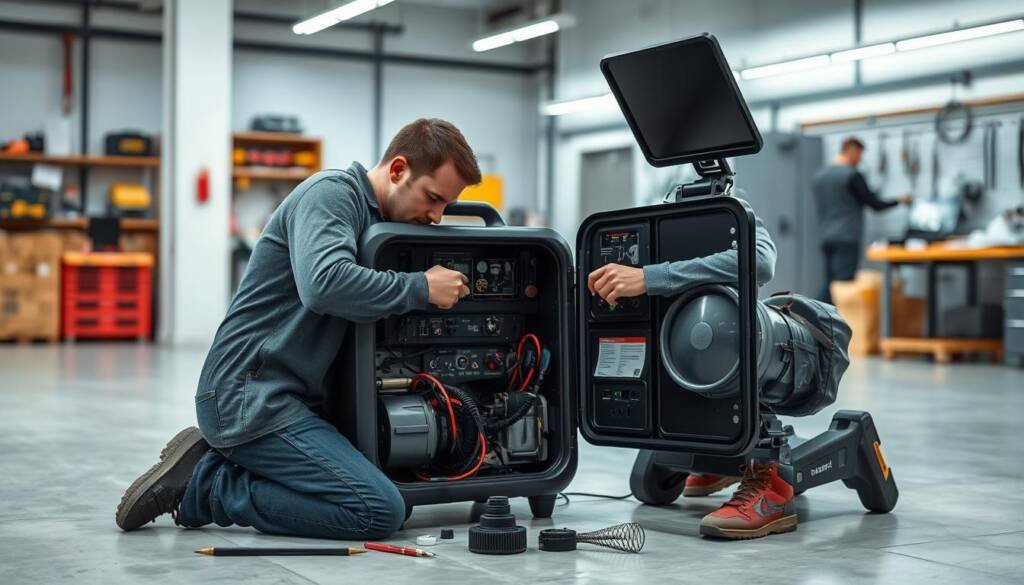Ever wondered why some portable power stations last years while others fail prematurely? The answer lies in how they are maintained and used. A portable power station is more than just a backup energy source; it’s an investment in reliability, whether for outdoor adventures or emergency preparedness.
Understanding the basics, like energy capacity measured in watt-hours and output limitations in watts, is crucial. For instance, a station with a 200-watt output can’t power a 300-watt device. Adhering to manufacturer guidelines ensures sustainable usage and prevents common issues like overcharging or overheating.
Innovation in battery technology, such as lithium-ion and LiFePO4, has revolutionized portable power. However, even the best batteries need proper care. Simple practices, like avoiding extreme temperatures and keeping the charge between 20-80%, can significantly extend the unit’s lifespan. For more detailed strategies, visit portablepowerstationbattery.com.
Key Takeaways
- Maintain charge levels between 20-80% to optimize battery health.
- Avoid overloading the power station beyond its output capacity.
- Store in a cool, dry place to prevent damage from extreme temperatures.
- Follow manufacturer guidelines for charging and usage.
- Regularly cycle the battery to recalibrate its management system.
Understanding Portable Power Stations
Understanding the inner workings of portable power stations is key to their longevity. These devices rely on advanced battery technology and precise operational parameters to deliver reliable energy. Knowing the components and how they function can help users make informed decisions about usage and maintenance.
Key Components and Battery Types
At the heart of every portable power station is its battery. The most common types are lithium-ion (Li-ion) and lithium iron phosphate (LiFePO4). Li-ion batteries are lightweight and efficient, offering 500 to 1,000 charge cycles. On the other hand, LiFePO4 batteries are more durable, lasting up to 5,000 cycles or more.
Each battery type has its strengths. Li-ion is ideal for portability, while LiFePO4 excels in longevity. Choosing the right one depends on your needs, whether it’s for short trips or long-term use.
Fundamental Operational Parameters
Portable power stations are defined by their capacity, measured in watt-hours (Wh), and output wattage. For example, a 200W station can’t power a 300W device. Matching the station’s output to your device’s requirements is crucial to avoid damage.
Temperature also plays a significant role. High heat above 86°F can accelerate battery aging, while storing the unit in a cool, dry place helps maintain its lifespan. Proper care ensures the station remains reliable for years to come.
Charging Habits for Longevity

Proper charging habits are the cornerstone of extending the life of your energy source. Whether you’re powering up for an outdoor adventure or preparing for an emergency, how you charge your device matters. Overcharging or deep discharging can significantly reduce its lifespan, making it essential to adopt smart practices.
Avoiding Overcharging and Deep Discharging
Overcharging and deep discharging are two of the most common mistakes that degrade battery health. Overcharging can cause overheating, while deep discharging strains the battery’s capacity. To avoid these issues, recharge your unit when it reaches 20-30% capacity and stop charging once it’s full.
Real user experiences show that these practices can extend the operational life of your device. For example, keeping the charge between 20-80% helps maintain the battery’s efficiency and reduces wear over time.
Using the Correct Chargers
Using the right charger is just as important as how you charge. Manufacturer-approved chargers are designed to match the unit’s specifications, ensuring both safety and efficiency. Off-brand or incompatible chargers can lead to overheating or even damage the battery.
Fast charging features are convenient, but they should be used sparingly. While they reduce charging time, frequent use can accelerate battery degradation. For more tips on selecting the right charger, check out this guide on choosing the perfect portable battery power.
Optimizing Temperature Control and Storage

Temperature plays a critical role in the performance and longevity of energy storage devices. Whether it’s extreme heat or freezing cold, environmental conditions can significantly impact battery capacity and overall efficiency. By adopting smart practices, you can ensure your unit remains in top condition for years.
Maintaining Optimal Temperature
High heat above 86°F can accelerate battery aging, while freezing temperatures reduce its capacity. For example, leaving your device in a hot car or under direct sunlight can cause irreversible damage. Similarly, using it in freezing conditions can strain the internal components.
To maintain optimal performance, store and use your device within the recommended temperature range of 32°F to 104°F. This simple practice ensures the battery operates efficiently and extends its lifespan.
Proper Storage Practices
When not in use, proper storage is essential. A cool, dry place is ideal to prevent damage from extreme temperature fluctuations. Avoid areas like garages or attics where temperatures can vary drastically.
Additionally, maintain a 40-50% state of charge during inactivity. This practice helps preserve the battery’s condition and prevents degradation. Periodic cycling, or using the device every few months, also recalibrates the battery management system.
Following manufacturer guidelines ensures your unit remains reliable. For instance, storing lithium batteries at around 60°F is recommended for maximum capacity retention. By adhering to these tips, you can improve both durability and performance.
Effective Usage Habits to Extend Service Life
Adopting smart usage habits can significantly enhance the durability of your energy solution. By avoiding common mistakes and implementing strategic practices, you can ensure your device remains efficient and reliable for years.
Avoiding Overloading and Idle Consumption
Exceeding the maximum output capacity can cause internal damage and trigger protection circuits. For example, powering a 300W device with a 200W station can strain the system. Always match the device’s wattage to the station’s output to prevent overheating or failure.
Minimizing idle power consumption is equally important. Turn off unnecessary features like LED lights or unused ports when not in use. This simple step reduces energy waste and preserves the battery’s cycle life.
Strategic Power Management
Assign high-wattage tasks during periods of high charge and switch to low-wattage tasks as the battery level drops. For instance, run a refrigerator when the station is fully charged and switch to charging phones as the charge decreases. This approach optimizes energy usage and extends the lifespan portable power solution.
Regular maintenance cycles, such as periodic full discharges and routine checks, are essential. These practices recalibrate the battery management system and support overall efficiency. Experts recommend cycling the battery every few months to maintain peak performance.
- Match device wattage to the station’s output to avoid overloading.
- Turn off unused features to minimize idle consumption.
- Assign tasks based on battery levels for optimal energy use.
- Conduct regular maintenance cycles to recalibrate the system.
By following these guidelines, you can maximize both performance and longevity. Small changes in daily habits lead to significant improvements in your device’s lifespan portable reliability.
How to Maximize the Lifespan of Your Portable Power Station

Ensuring your energy solution lasts for years requires more than just occasional care. Consistent maintenance and adherence to guidelines are the keys to maximizing its performance and life. By following the manufacturer’s instructions and adopting routine practices, you can prevent damage and keep your device in top shape.
Following Manufacturer Guidelines
Every device comes with specific instructions tailored to its components and design. Ignoring these guidelines can lead to avoidable issues. For example, using incompatible chargers or exceeding the recommended charge cycles can strain the battery and reduce its life.
Manufacturers often provide detailed protocols for charging, usage, and storage. Adhering to these ensures optimal performance and prevents long-term damage. As one expert notes,
“Proper care starts with understanding the manual—it’s your roadmap to reliability.”
Regular Maintenance Practices
Routine care is essential for extending the life of your device. Simple steps like firmware updates, periodic full discharge cycles, and system recalibration can make a significant difference. These practices help maintain the battery’s efficiency and prevent internal component stress.
For instance, keeping the charge level between 20-80% during regular use minimizes wear. Additionally, storing the unit in a cool, dry place protects it from environmental damage. Real-world examples show that users who follow these steps enjoy longer-lasting devices.
- Read and follow the manufacturer’s guidelines for charging and usage.
- Perform firmware updates to ensure optimal performance.
- Conduct periodic full discharge cycles to recalibrate the system.
- Store the device in a cool, dry place to prevent damage.
- Monitor battery health and replace components as needed.
By integrating these practices into your routine, you can significantly extend the life of your energy solution. Consistent care not only enhances performance but also ensures reliability for years to come.
Incorporating Solar Panels and Accessories
Integrating solar panels and accessories can significantly boost the functionality and sustainability of your energy solution. These additions not only enhance output but also contribute to a greener environment. Whether you’re camping off-grid or preparing for emergencies, solar energy offers a reliable and eco-friendly alternative to traditional charging methods.
Leveraging Solar Energy
Solar panels harness renewable energy, reducing reliance on grid power and minimizing discharge cycles. For outdoor enthusiasts, this means continuous power supply even in remote locations. Modern panels, like those from OUPES, are designed for high efficiency, ensuring faster charging and improved durability.
Using solar energy also aligns with sustainable practices. As one expert notes,
“Solar power not only extends the life of your device but also reduces your carbon footprint.”
This dual benefit makes it an ideal choice for environmentally conscious users.
Adding Supplementary Batteries
Supplementary batteries can expand your system’s capacity, providing extended usage without frequent recharging. However, compatibility is key. Always ensure that additional batteries match your unit’s specifications to avoid overloading internal components.
For example, the OUPES Mega series supports external batteries, allowing users to scale their energy storage as needed. This flexibility is particularly useful for long-term off-grid setups or emergency backup systems.
- Solar panels reduce reliance on traditional charging methods, ensuring continuous power.
- Supplementary batteries expand capacity, enhancing output and usability.
- Compatibility with accessories prevents overload and protects internal components.
- Follow manufacturer guidelines for safe and efficient integration.
By incorporating these accessories, you not only improve performance but also contribute to a more sustainable environment. For more tips on maximizing portable power stations lifespan, explore our detailed guide.
Conclusion
Proper care and smart usage are essential for maintaining the efficiency of your energy solution. By following manufacturer guidelines, you can protect advanced components like lithium-ion batteries and ensure long-term reliability. Avoiding excessive heat and storing the unit in a cool, dry place are simple yet effective practices.
Integrating solar panels not only enhances sustainability but also reduces reliance on traditional charging methods. This eco-friendly approach aligns with modern energy needs while extending the level of performance. For more detailed strategies, visit Topwell Power.
Regular monitoring and maintenance are key. Keep the charge between 20-80%, cycle the battery periodically, and ensure compatibility with accessories. These steps help maximize the product’s lifespan and reliability.
By adopting these practices, you can enjoy a dependable energy solution for years. Embrace sustainable energy and technical diligence to stay ahead in the evolving world of renewable power.